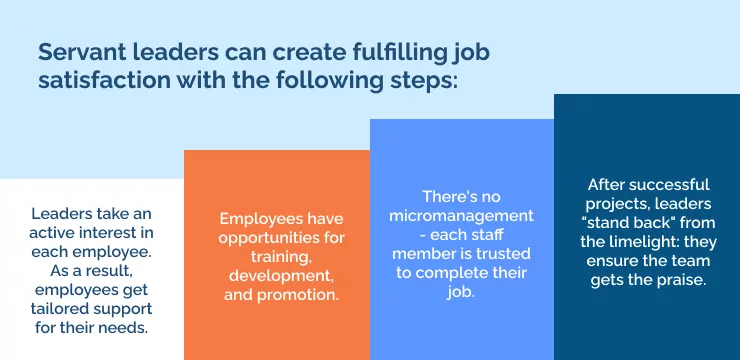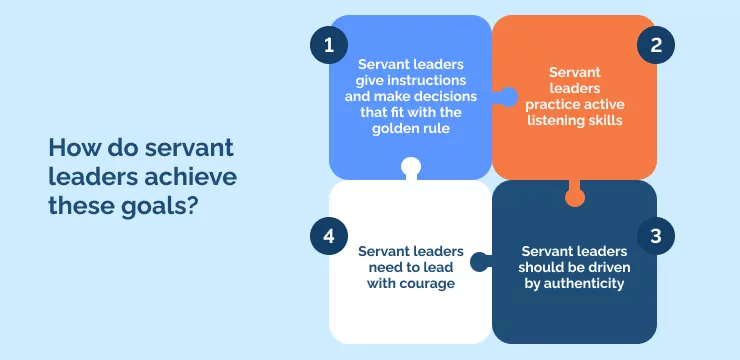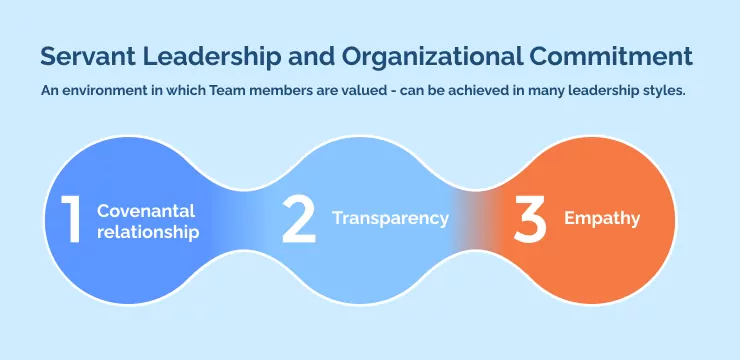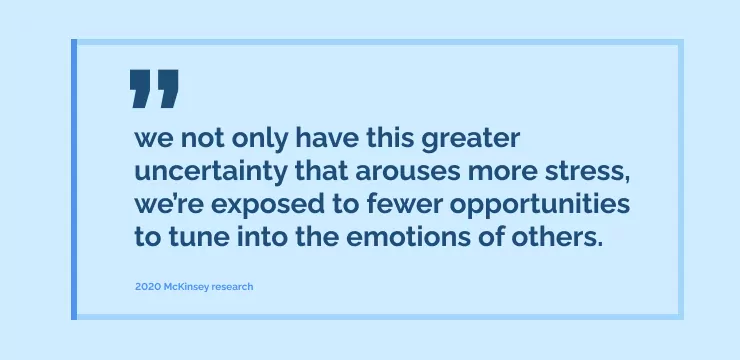
Everyone agrees that there are many benefits to servant leadership. But not everyone agrees on what the most important benefits are. We’ve looked through pages of google results, academic journals, business research, and more to find out fundamental benefits.
That’s why we will start with a big overview of the benefits. You’ll be able to preview all the outcomes you might
Then, we will dive deep into the five key benefits of leading teams with a servant-leader model—job satisfaction, organizational commitment, trust, well-being, and team effectiveness. As a special bonus prize, we’ll briefly mention two top benefits of training.
Before finishing the article, we will also say a few words about the downsides of servant leadership. After all – no leadership style is perfect! And if you’re trying to figure out the best leadership style for your next change management or organizational development project, you must consider the whole picture.
An Overview of Servant Leadership Benefits

There’s a lot of writing about Servant Leadership out there. There’s so much that some researchers have produced lists of all the benefits of this style.
Two of our favorites are from a 2019 article by Lemoine, Hartnell, and Leroy and the book by Gary Roberts, Servant Leadership Human Resources (2014). If we put their lists together, we get something like this:
- Affect and cognitive trust
- Commitment (many!)
- Commitment to Change
- Creativity and Innovation
- Empathy
- Engagement
- Interpersonal Trust
- Organizational Trust
- Organizational Citizenship
- Procedural Justice
- Satisfaction
- Positive work climate
- Team Effectiveness
- Employee well-being
- Reduced staff turnover
That’s a big list! Some of these benefits will also come from other “moral” leadership styles (like “ethical leadership” or “authentic leadership”). But it reminds us how the right leader can make a brilliant impact on any organization.
Servant Leadership and Job Satisfaction
A 2021 Gartner report explained that job success is a much bigger concept than once. Now, companies must see success in performance and overall employee health.

Servant leaders can create fulfilling job satisfaction with the following steps:
- Leaders take an active interest in each employee. As a result, employees get tailored support for their needs.
- Employees have opportunities for training, development, and promotion.
- There’s no micromanagement – each staff member is trusted to complete their job.
- After successful projects, leaders “stand back” from the limelight: they ensure the team gets the praise.
The benefits for job satisfaction also include the leaders themselves. Leaders act with humility, connection, and empathy and reduce the risk of isolation and stress from difficult decisions. Servant leaders recognize their limitations and reach out for help when needed!
Servant Leadership and Trust
Leaders are a “crucial element of success” for building trust, as a 2022 Harvard Business blog explained.
As seen in the list above, servant leadership is especially good at creating trust in interpersonal, organizational, and emotional (cognitive/affective).

How do servant leaders achieve these goals?
- Servant leaders give instructions and make decisions that fit with the golden rule. Any request they ask of someone else, they would do it themselves.
- Servant leaders practice active listening skills.
- Servant leaders should be driven by authenticity. This means employees see their leaders as reliable, consistent, and values-driven.
- Servant leaders need to lead with courage. They take the first step in difficult situations so their team does not have to.
There are many benefits when it is normal for staff to experience trust.
- Staff can share their opinions freely. They can trust their managers to understand and respond positively if they have any kind of problem, need, or opinion.
- The staff knows that they can try innovative approaches to their work. If the legacy systems can improve, staff are empowered to find a better way.
- Everyone can take risks – if their motivations are good, they will be treated respectfully.
Building trust is a winning situation. Staff work better, with improved morale, and (potentially) with long-term organizational commitment – which is our next benefit!
Servant Leadership and Organizational Commitment

When employees feel connected to their organization, they have a strong sense of organizational commitment.
Organizational commitment is generated from the emotional investment, an active desire to remain in the company, and a positive sense of responsibility. Employees with a commitment to their organization are highly loyal.
Over time, servant leadership can improve organizational commitment:
An environment in which Team members are valued – can be achieved in many leadership styles.
- Organizations enter into a covenantal relationship with their staff
- At every level, there is transparency around strategy and decision-making
- Leaders use empathy to create an atmosphere of interpersonal acceptance.
These actions all help to produce a positive work environment. But they also lead to key businesses that move the business forward. Organizational commitment helps to get the best out of staff without stretching them beyond their limits. Commitment helps to reduce staff turnover. And as a result, it is easy to devise long-term plans and organizational goals.
Organizational commitment could mean that staff is willing to work late one week – because they know their needs will be met. A servant leader can understand this balance and make informed decisions about what to ask of their team members.
Servant Leadership and Employee Well-being
In one email, a corporation invites its staff to free yoga lessons for well-being purposes. In the next, they announce widespread redundancies. Does this company care about staff well-being? A servant leader would say “no.”
Servant leadership makes well-being part of the everyday working environment. With the principles of servant leadership, managers understand the deepest concepts that make people feel positive about work. These include empathy, emotional intelligence, and psychological safety.

Staff well-being is more important than ever. As 2020 McKinsey research explained, current working practices are particularly challenging: “we not only have this greater uncertainty that arouses more stress, we’re exposed to fewer opportunities to tune into the emotions of others.”
Servant leaders must genuinely care about the needs of their staff – and be prepared to support them through thick and thin.
Servant Leaders and Team Effectiveness
The servant leadership of a team can feel counterintuitive. After all, it requires leaders to give up their control and trust their team members to perform their roles effectively.
.Some of the core servant leader principles for effective team leadership include:
- Empowering staff to make independent and collaborative decisions about their work
- Standing back from the day-to-day workflow
- Using non-authoritative stewardship to facilitate the best work from your employees.
Agile management is one environment where servant leaders excel, as the agile methodology emphasizes collaboration, adaptability, and continuous improvement.
In an agile team, the team leader takes on a service role, supporting the team by arranging stand-up meetings, ensuring that all voices are heard, and facilitating decision-making without imposing their ideas. These strategies empower team members to work independently while encouraging them to consult and collaborate to achieve their goals.
Team effectiveness can be measured through various factors: including productivity, quality of work, innovation, job satisfaction, and overall team morale. With servant leadership, managers will be ready to deliver on these metrics.
There is Lots of Servant Leadership Theory
If you want to develop your skills as a servant leader, I’ve got some good news. There are many resources to help you out.
Since Greenleaf started writing about servant leadership in the 1970s, there’s been half a century of progress in the field. Business leaders and researchers have written whole books about servant leadership. Some books explain the principles, some show how they work in practice, and others give long case studies about particular industries or companies.
If you’re in a sector where servant leadership is common – that’s great! You can easily find someone who has led the way forward. And if you’re in an industry that runs with traditional leadership styles – surely you will be able to find an example that has gone before you.
Our article about servant leadership examples [Link?] can give you more information about how it can work in real-life situations.
… But Anyone can be a Servant Leader!
On the other hand, a manager uses servant leadership just by changing their mindset.
Martin Luther King Jr understood this very well. He famously explained that service is a very simple concept:
“You don’t have to have a college degree to serve. You don’t have to make your subject and verb agree to serve. You don’t have to know about Plato and Aristotle to serve…You only need a heart full of grace. A soul generated by love. And you can be that servant.”
Most business leaders do not want to achieve the radical results of King’s organizational leadership tactics. But many people can improve the lives of their employees by employing the same principles.
The Cons of Servant Leadership

As you can see, servant leadership is great for many reasons. But it has some downsides too. You need to know the full picture – so let’s take a quick look at some of the negative aspects of servant leadership.
- Servant leadership can be time-consuming. Servant leaders see each staff member as an individual: getting to know each of them takes time.
- Servant leadership should create a positive working environment. Sadly, if it is used without emotional intelligence, it has the potential to create a climate of toxic positivity. This can isolate and de-motivate staff – the opposite of servant leadership’s goals!
- If the organization does not recognize this leadership style, an individual manager may struggle to be a true servant leader.
- Servant leadership may not give the blueprint for every situation, depending on your environment. For situations that need direct instructions, a servant leader has to become more like a formal authority figure to perform well.
Good leaders can successfully deal with these weaknesses. But they must be aware of them before they even start.
Servant Leadership: An Overview
This distinctive leadership style is still relevant in the digital age thanks to many servant leadership benefits.
Consider how different “remote” work is compared to old-style desk-bound work. Many people love working from home. But with it comes the risk of emotional detachment, micromanagement, and obsessive target-setting.
So it’s interesting that Gartner’s research from 2022 showed that authenticity, empathy, and adaptivity were crucial skills for the next generation of leaders. Digital managers in 2023 gather data about their teams from many sources, such as using digital adoption platforms to monitor software usage. The principles of servant leadership make us understand how to use this data: to support, encourage, and guide every employee.
In some workplaces, this leadership style will still feel radical. But there’s no doubt that servant leadership can be a part of a successful leadership vision for business leaders in every sector.
WalkMe Team
WalkMe spearheaded the Digital Adoption Platform (DAP) for associations to use the maximum capacity of their advanced resources. Utilizing man-made consciousness, AI, and context-oriented direction, WalkMe adds a powerful UI layer to raise the computerized proficiency, everything being equal.



